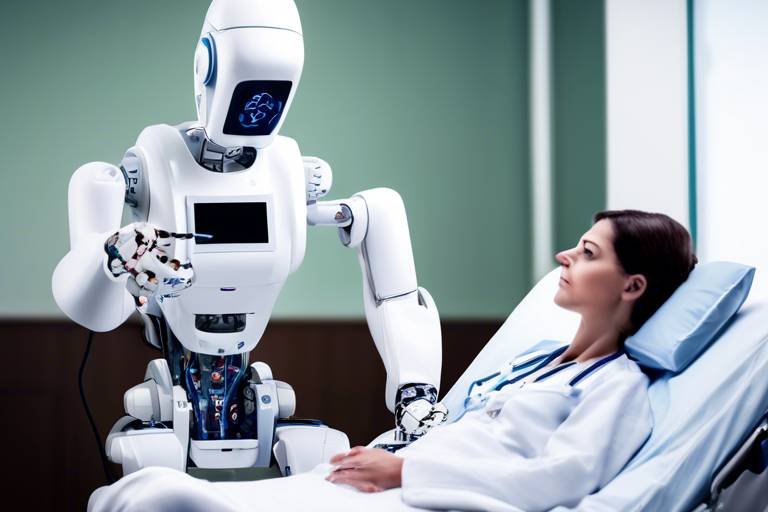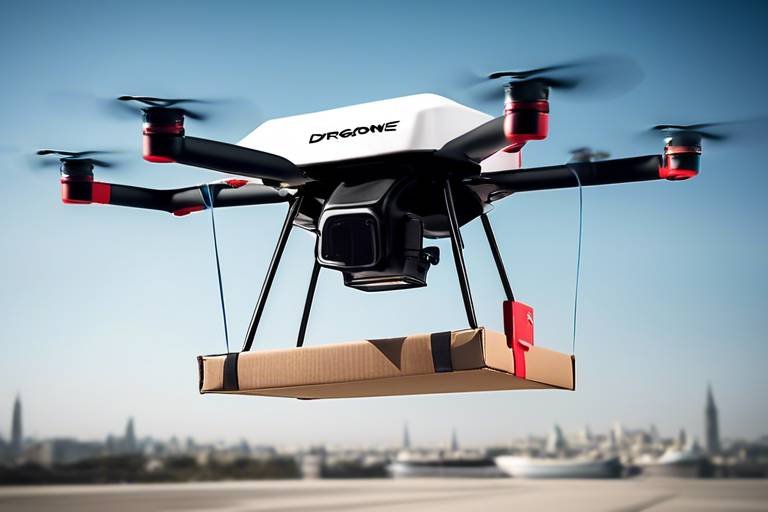The Role of Robotics in Healthcare Delivery
In today's fast-paced world, the integration of robotics in healthcare is nothing short of revolutionary. Imagine a world where surgeries are performed with pinpoint accuracy, where patients can recover faster, and where healthcare providers can operate with unprecedented efficiency. This is not a distant dream but a reality that has been unfolding over the past few years. Robotics is transforming the landscape of healthcare delivery, making it more effective and patient-centric. With each advancement, we are not just enhancing technology; we are enhancing lives.
As we dive deeper into this topic, it's essential to understand the transformative impact of robotic systems across various facets of healthcare. From surgical procedures to rehabilitation, the applications of robotics are vast and varied. These systems are designed not just to assist healthcare professionals but to also improve the overall patient experience. As we explore the advancements in robotic technology, applications in surgery, and the future potential of robotics, we will uncover how these innovations are shaping the future of healthcare delivery.
What does this mean for patients and healthcare providers alike? Well, the answer is clear: enhanced accuracy, efficiency, and ultimately, a better quality of care. As robotics continues to evolve, so too does the potential for improved patient outcomes. So, let’s embark on this journey to discover how robotics is not just a tool but a partner in healthcare delivery.
Recent innovations in robotic technology have significantly enhanced their capabilities, enabling more precise surgeries and efficient patient management. For instance, advancements in artificial intelligence and machine learning are allowing robots to learn from previous procedures, making them increasingly adept at performing complex tasks. These technologies are not just improving the tools available to surgeons; they are redefining what is possible in the operating room.
Moreover, the development of telemedicine and remote robotic systems is allowing healthcare providers to reach patients in remote areas, ensuring that quality care is accessible to everyone, regardless of location. The combination of these advancements is paving the way for a future where healthcare is not just reactive but proactive, focusing on prevention and early intervention.
Robotic systems are increasingly utilized in surgical procedures, providing surgeons with enhanced precision and control. This is particularly evident in fields such as urology, gynecology, and orthopedics, where robotic-assisted surgeries are becoming the norm. The ability to perform complex procedures with minimal invasiveness is a game-changer, offering patients a host of benefits.
Minimally invasive robotic surgery techniques reduce recovery time and minimize scarring. This is not just a technical improvement; it’s a significant shift in how we approach surgery. Patients can return to their daily lives much quicker than with traditional surgical methods. For example, patients undergoing robotic-assisted laparoscopic procedures often experience less pain and shorter hospital stays.
The benefits of minimally invasive techniques include:
- Shorter hospital stays
- Quicker recovery times
- Reduced pain and discomfort
- Less scarring
These advantages not only enhance patient satisfaction but also lead to significant cost savings for healthcare facilities. It’s a win-win situation!
Despite their benefits, implementing robotic systems in surgical settings poses challenges, including costs and training. The initial investment in robotic technology can be substantial, and healthcare institutions must also consider the ongoing costs of maintenance and updates. Additionally, training medical staff to effectively use these systems is crucial. Without proper training, the potential of robotic systems cannot be fully realized, and patient safety may be compromised.
Robotic systems are also making strides in rehabilitation, assisting patients in recovering mobility and strength. Devices such as exoskeletons and robotic arms are being used to support patients as they regain their independence. These technologies not only facilitate physical recovery but also provide emotional support, helping patients feel empowered in their rehabilitation journey.
The integration of robotics in healthcare significantly improves patient care by enhancing accuracy and efficiency. Robotic systems are designed to complement the skills of healthcare professionals, allowing them to focus on what they do best—caring for patients. This not only improves outcomes but also enhances the overall patient experience.
Robots are being used for patient monitoring and assistance, providing real-time data and support. These systems can alert healthcare providers to changes in a patient's condition, ensuring timely interventions. The result? Improved patient safety and care quality. Imagine a scenario where a robot can notify a nurse if a patient’s vitals are trending in a concerning direction, allowing for quicker responses and ultimately saving lives.
Looking ahead, the future of robotics in healthcare appears promising, with ongoing research and development. Innovations such as AI-driven surgical robots and advanced rehabilitation devices are on the horizon. As these technologies continue to evolve, we can anticipate even greater improvements in healthcare delivery.
In conclusion, the role of robotics in healthcare delivery is not just about technology; it’s about enhancing human lives. As we embrace these advancements, we must also address the challenges that come with them. By doing so, we can create a future where quality healthcare is accessible to all, and where technology and humanity work hand in hand.
- What are the main benefits of robotic surgery?
Robotic surgery offers numerous benefits, including increased precision, reduced recovery time, and less postoperative pain.
- Are robotic systems expensive to implement?
Yes, the initial costs can be high, but the long-term savings and improved patient outcomes often justify the investment.
- How is robotics used in rehabilitation?
Robotic systems assist patients in regaining mobility and strength, providing support and motivation during their recovery process.

Advancements in Robotic Technology
Recent innovations in robotic technology have significantly enhanced their capabilities, enabling more precise surgeries and efficient patient management. The integration of artificial intelligence (AI) with robotics has paved the way for systems that not only perform tasks but also learn and adapt over time. For instance, robotic surgical systems now utilize machine learning algorithms to analyze vast amounts of surgical data, improving their precision and outcomes. This means that the more they are used, the better they become at assisting surgeons, ultimately leading to safer procedures.
Moreover, advancements in sensor technology have made it possible for robots to gather real-time data about patients' conditions. For example, robotic systems can now monitor vital signs continuously, alerting healthcare professionals to any changes that may require immediate attention. This capability not only enhances the quality of patient care but also allows for timely interventions that can save lives.
Another remarkable advancement is the development of telepresence robotics, which allows healthcare providers to interact with patients remotely. This technology is especially beneficial in rural or underserved areas where access to specialized medical care is limited. With telepresence robots, doctors can perform consultations and even guide on-site staff during procedures, bridging the gap between patients and healthcare providers.
To illustrate the impact of these advancements, consider the following table that outlines some key technologies and their implications:
| Technology | Implication |
|---|---|
| Artificial Intelligence | Enhances surgical precision and outcomes through data analysis. |
| Sensor Technology | Allows for continuous monitoring of patient vitals and conditions. |
| Telepresence Robotics | Facilitates remote consultations and guidance for healthcare providers. |
These advancements are not just technological feats; they represent a shift in how we approach healthcare delivery. As robots become more integrated into healthcare systems, they are transforming the roles of medical professionals. Surgeons can now focus more on critical decision-making while relying on robotic systems to handle repetitive or precise tasks. This collaboration between humans and robots is akin to a well-rehearsed dance, where each partner plays a vital role in achieving a common goal: improving patient outcomes.
However, it’s essential to recognize that with these advancements come challenges. The cost of implementing robotic systems can be significant, and training healthcare professionals to work alongside these technologies is crucial for maximizing their potential. As we continue to explore the advancements in robotic technology, it’s clear that the future of healthcare is not just about machines; it’s about enhancing the human experience in medicine.
- What are the main benefits of robotic technology in healthcare?
Robotic technology enhances precision in surgeries, improves patient monitoring, and facilitates remote consultations, ultimately leading to better patient outcomes.
- How does artificial intelligence improve robotic surgery?
AI analyzes surgical data to enhance the accuracy of robotic systems, allowing them to learn and adapt over time, which improves surgical outcomes.
- What challenges do healthcare institutions face when implementing robotic systems?
The primary challenges include high costs, the need for specialized training, and integration with existing healthcare workflows.

Applications in Surgery
Robotic systems are increasingly utilized in surgical procedures, providing surgeons with enhanced precision and control that can redefine the very fabric of surgical practices. Imagine a world where the surgeon's hands are augmented by technology, allowing for movements that are not just precise but also incredibly steady. This is not science fiction; it's the reality of modern medicine, where robotic-assisted surgeries are becoming the norm rather than the exception. The applications of robotics in surgery extend across various fields, including urology, gynecology, and orthopedics, each benefiting from the unique capabilities that robotic systems offer.
One of the standout features of robotic surgery is its ability to perform complex procedures through small incisions, which significantly reduces trauma to the patient's body. The da Vinci Surgical System, for example, is one of the most recognized robotic platforms and is widely used for prostatectomies, hysterectomies, and other delicate operations. By translating the surgeon's hand movements into smaller, more precise actions of tiny instruments, the da Vinci system allows for unparalleled accuracy. This system enhances the surgeon's vision with a 3D high-definition view of the surgical area, making it easier to navigate around intricate anatomical structures.
Moreover, the advantages of robotic-assisted surgeries aren't just limited to the operating room. They also extend to the overall patient experience. Patients undergoing robotic surgeries often experience:
- Reduced Pain: Smaller incisions lead to less pain post-operation.
- Shorter Recovery Times: Many patients can return home the same day or the next day.
- Lower Risk of Infection: Minimally invasive techniques reduce exposure to potential contaminants.
However, while the benefits are substantial, it's essential to address the challenges that come with integrating robotic systems into surgical practices. High costs associated with purchasing and maintaining robotic systems can be a significant barrier for many healthcare institutions. Additionally, there is a steep learning curve for surgeons who must undergo extensive training to master these advanced technologies. Hospitals must balance the initial investment with the long-term benefits, often leading to difficult decisions regarding resource allocation.
In summary, the applications of robotics in surgery are not just reshaping how surgeries are performed; they are revolutionizing patient outcomes and the overall healthcare experience. As technology continues to advance, we can expect even more innovative applications that will push the boundaries of what is possible in surgical care.

Minimally Invasive Surgery
Minimally invasive surgery (MIS) is like a breath of fresh air in the surgical world, revolutionizing how procedures are performed and significantly enhancing patient recovery. Imagine undergoing a complex operation with just a few tiny incisions instead of a large, gaping wound. That’s the magic of MIS! This innovative approach utilizes advanced robotic systems that allow surgeons to perform intricate procedures with unparalleled precision. As a result, patients benefit from shorter recovery times, reduced pain, and minimal scarring, which can be a game changer for anyone facing surgery.
So, how does it work? During minimally invasive procedures, surgeons use robotic-assisted tools that are controlled via a console. These tools can navigate through the body with exceptional dexterity, allowing for more accurate movements than the human hand alone. For instance, a surgeon can make precise cuts and sutures that are often impossible with traditional methods. This level of control not only leads to better surgical outcomes but also significantly lowers the risk of complications.
One of the standout features of minimally invasive surgery is its ability to reduce hospital stays. Patients can often go home the same day or the next day after their procedure. This is a stark contrast to traditional surgery, where extended hospital stays are the norm. The benefits don’t stop there; patients report experiencing less postoperative pain and a quicker return to their daily activities. It’s almost as if the body has been given a head start on healing!
However, it’s important to note that while the advantages of minimally invasive surgery are compelling, there are challenges that healthcare providers must navigate. For instance, the initial investment in robotic systems can be substantial, and not all hospitals have the budget to make this leap. Additionally, training medical staff to operate these sophisticated machines requires time and resources. Despite these hurdles, the momentum towards adopting minimally invasive techniques continues to grow.
In summary, minimally invasive surgery represents a significant leap forward in the field of healthcare. It combines technology and medical expertise to offer patients safer, less painful, and more effective surgical options. With ongoing advancements in robotic technology, the future looks bright for patients seeking surgical solutions that prioritize recovery and quality of life.

Benefits of Minimally Invasive Techniques
Minimally invasive techniques in robotic surgery have revolutionized the way we approach surgical procedures, offering a plethora of benefits that significantly enhance patient care. One of the most remarkable advantages is the reduction in recovery time. Traditional surgeries often leave patients with long-lasting pain and extended hospital stays, but with minimally invasive methods, many patients can return home within a day or two. This not only improves patient satisfaction but also reduces the burden on healthcare facilities.
Another critical benefit is the minimization of scarring. Conventional surgeries typically involve large incisions, which can lead to noticeable scars. In contrast, robotic-assisted surgeries utilize tiny incisions, often no bigger than a pencil tip. This is akin to the difference between using a sledgehammer and a precision tool; the latter allows for greater finesse and less disruption to the surrounding tissue. Patients appreciate this aesthetic advantage, as it contributes to a more positive body image post-surgery.
Moreover, the precision offered by robotic systems translates into lower risk of complications. Surgeons can navigate complex anatomical structures with enhanced control, leading to fewer mistakes and reduced chances of infection. For instance, studies have shown that robotic surgeries often result in lower rates of blood loss and shorter operating times. This is crucial because a shorter operation not only means less time under anesthesia but also less strain on the patient's body overall.
In addition to these physical benefits, there’s also a psychological aspect to consider. Patients undergoing minimally invasive procedures often experience less anxiety due to the quicker recovery and reduced pain associated with these techniques. The overall experience of surgery becomes less daunting, which can lead to better mental health outcomes during recovery. When patients feel more comfortable and informed, their recovery process can be smoother and more effective.
Here’s a quick summary of the key benefits of minimally invasive techniques:
- Reduced recovery time leading to quicker return to daily activities.
- Minimized scarring which enhances aesthetic outcomes.
- Lower risk of complications due to enhanced precision.
- Improved psychological comfort for patients, leading to better overall outcomes.
In summary, the shift towards minimally invasive techniques in robotic surgery is not just a trend—it's a transformative approach that prioritizes patient well-being. As technology continues to advance, we can expect these benefits to expand, further solidifying the role of robotics in the future of healthcare.
1. What is minimally invasive surgery?
Minimally invasive surgery involves techniques that use small incisions, allowing for quicker recovery and less pain compared to traditional surgery.
2. How does robotic surgery differ from traditional surgery?
Robotic surgery provides surgeons with enhanced precision and control through advanced technology, often resulting in better outcomes for patients.
3. Are there risks associated with robotic surgery?
Like any surgical procedure, there are risks, but minimally invasive techniques generally result in fewer complications compared to traditional methods.
4. How can I prepare for a robotic-assisted surgery?
Preparation may include discussing your medical history with your surgeon, understanding the procedure, and following any pre-operative instructions provided.

Challenges in Implementation
Implementing robotic systems in surgical settings is not without its hurdles. While the benefits of these advanced technologies are clear, the road to integration can be quite bumpy. One of the primary challenges is the **high cost** associated with acquiring and maintaining robotic surgical systems. Hospitals often face significant financial constraints, making it difficult to justify the investment, especially when budgets are tight. For instance, the initial purchase price of a robotic surgical system can range from $1 million to $2.5 million, not including the ongoing costs of maintenance and training.
Moreover, the **training** required for healthcare professionals to operate these sophisticated machines is another significant barrier. Surgeons and support staff need specialized training to become proficient in robotic-assisted procedures. This training can take time, often requiring several weeks to months, which can disrupt regular surgical schedules and incur additional costs. For example, a hospital may need to allocate funds for training programs, which could otherwise be used for patient care or other essential services.
Additionally, there are **technical challenges** that can arise during the implementation process. Integrating robotic systems with existing hospital infrastructure, including electronic health records and other medical devices, can be complex. There may also be concerns about the reliability of robotic systems, especially in high-stakes environments like surgery. Hospitals must ensure that these machines are not only effective but also safe for patient use. Any malfunction during a procedure could have dire consequences, leading to a reluctance among some practitioners to fully embrace robotic technology.
Lastly, there is often a **cultural resistance** within healthcare institutions. Some surgeons may be hesitant to adopt robotic systems, preferring traditional surgical methods that they are more comfortable with. This reluctance can stem from a fear of change or a lack of understanding of how robotics can enhance surgical outcomes. Overcoming this resistance requires education, showcasing the advantages of robotic systems, and demonstrating successful case studies where these technologies have led to improved patient results.
In summary, while the potential of robotics in healthcare is immense, the challenges in implementation cannot be overlooked. Addressing these obstacles requires a concerted effort from hospital administration, surgical teams, and technology providers to ensure that the transition to robotic-assisted procedures is smooth and beneficial for all parties involved.
- What are the main benefits of robotic surgery? Robotic surgery offers enhanced precision, reduced recovery times, and minimal scarring compared to traditional surgical methods.
- How much does robotic surgery cost? The cost of robotic surgery can vary widely, but initial investments in robotic systems can exceed $1 million.
- Are there risks associated with robotic surgery? While robotic surgery is generally safe, there is a risk of technical malfunctions and the need for skilled operators to minimize complications.
- How long does training for robotic surgery take? Training can take several weeks to months, depending on the complexity of the system and the experience of the surgical team.
- Will robotic surgery replace traditional surgery? While robotic surgery is becoming more prevalent, it is unlikely to completely replace traditional methods; rather, it will complement them.

Robotics in Rehabilitation
In recent years, the field of rehabilitation has witnessed a remarkable transformation, thanks to the integration of robotic technology. Imagine a world where patients recovering from injuries or surgeries can regain their mobility and strength with the help of intelligent machines. This is not science fiction; it's happening right now! Robotic systems are being designed to assist individuals in their rehabilitation journey, making the process more efficient and engaging.
One of the most exciting aspects of robotics in rehabilitation is the development of robot-assisted therapy. These robots are equipped with advanced sensors and algorithms that allow them to adapt to each patient's unique needs. For instance, they can monitor a patient's movements in real-time and provide immediate feedback, which is crucial for effective recovery. This level of interaction ensures that patients remain motivated and engaged throughout their rehabilitation process.
Consider the case of stroke survivors, who often face significant challenges in regaining their motor skills. Robotic exoskeletons and rehabilitation robots can assist these individuals by guiding their movements and providing the necessary support. This not only helps in retraining the muscles but also boosts the patient's confidence, making them feel less isolated in their recovery journey.
Furthermore, robotic systems can be programmed to deliver personalized therapy sessions. This means that patients can receive tailored exercises that target their specific weaknesses, leading to a more effective rehabilitation experience. For example, a patient recovering from a knee surgery might use a robotic device that focuses on leg movements, gradually increasing the difficulty as their strength improves.
However, as with any technological advancement, there are challenges to consider. The integration of robotics in rehabilitation requires significant investment, both in terms of finances and training for healthcare professionals. Additionally, there may be resistance from patients who are unfamiliar with these technologies. To address these concerns, healthcare providers must prioritize education and demonstrate the tangible benefits that robotic systems can offer.
In summary, robotics in rehabilitation is revolutionizing how patients recover from injuries and surgeries. By providing personalized, engaging, and effective therapy, these technologies are paving the way for a future where recovery is not only achievable but also enjoyable. The fusion of human compassion and robotic precision is creating a new paradigm in patient care, one that holds great promise for the future.
- What types of robotic systems are used in rehabilitation?
Robotic systems used in rehabilitation include exoskeletons, robotic arms, and interactive therapy robots designed to assist with physical exercises. - How do robotic rehabilitation systems enhance recovery?
These systems provide real-time feedback, personalized exercises, and consistent support, which can lead to faster and more effective recovery. - Are robotic rehabilitation devices safe for all patients?
While generally safe, the suitability of robotic devices depends on individual patient conditions, and it’s essential to have a healthcare professional's guidance. - Can patients use robotic systems at home?
Some robotic rehabilitation devices are designed for home use, allowing patients to continue their therapy in a comfortable environment.

Impact on Patient Care
The integration of robotics in healthcare is not just a technological upgrade; it represents a paradigm shift in how we approach patient care. Imagine walking into a hospital where robots are seamlessly aiding healthcare professionals, enhancing the overall patient experience and outcomes. This is not a distant dream but a reality that is unfolding before our eyes. With robotic systems taking on various roles, from surgical assistance to patient monitoring, the healthcare landscape is evolving at an unprecedented pace.
One of the most significant impacts of robotics is the enhancement of accuracy in treatment and diagnosis. Robots equipped with advanced sensors and AI algorithms can analyze patient data and provide real-time feedback to medical staff. This capability allows for early detection of potential complications, ensuring timely intervention. For instance, robotic systems can monitor vital signs continuously, alerting healthcare providers if any abnormalities arise, which means that patients receive care faster than ever before.
Moreover, robotic technologies are improving the efficiency of healthcare delivery. By automating routine tasks, such as medication dispensing and patient transport, healthcare professionals can focus more on direct patient care. This not only enhances the quality of care but also reduces the workload on human staff, allowing them to spend more time with patients. In fact, studies have shown that hospitals utilizing robotic systems have reported a significant decrease in patient wait times and an increase in overall satisfaction.
Robots are also playing a crucial role in providing support for patients with limited mobility. For example, robotic exoskeletons are being used to assist individuals in regaining their ability to walk after severe injuries. These devices not only aid in physical recovery but also boost the patients' morale by giving them a sense of independence and accomplishment. The psychological benefits of such advancements cannot be overstated; patients feel empowered and motivated to engage in their recovery processes.
However, the integration of robotics in patient care is not without its challenges. While the benefits are clear, healthcare institutions must navigate issues related to cost and training. The initial investment in robotic systems can be substantial, and not all facilities may have the budget to implement these advanced technologies. Additionally, staff must be adequately trained to work alongside these systems, which can require significant time and resources. Despite these hurdles, the potential benefits far outweigh the challenges, making it essential for healthcare providers to invest in robotic technologies.
As we look to the future, the role of robotics in healthcare will likely expand even further. With ongoing research and development, we can anticipate new applications that will enhance patient care even more. For instance, robotic systems may soon be able to provide personalized treatment plans based on real-time data analysis, tailoring interventions to individual patient needs. This level of customization could revolutionize the way we approach healthcare, making it more effective and patient-centered.
- How do robotic systems improve patient safety?
Robotic systems enhance patient safety by providing real-time monitoring and alerts for any abnormalities in vital signs, enabling quicker responses from healthcare providers. - Are robotic surgeries more effective than traditional surgeries?
Yes, robotic surgeries often result in less blood loss, reduced pain, and quicker recovery times compared to traditional surgical methods. - What are the costs associated with implementing robotic systems?
The costs can vary significantly based on the type of robotic system and the specific healthcare setting, but they often include initial purchase, maintenance, and training expenses.

Patient Monitoring and Assistance
The integration of robotics in patient monitoring and assistance is not just a trend; it's a revolution that is reshaping the healthcare landscape. Imagine a world where patients can receive real-time updates about their health status without the constant need for human intervention. This is exactly what robotic systems are bringing to the table. With advanced sensors and artificial intelligence, these robots can continuously monitor vital signs, detect anomalies, and alert healthcare providers instantly. This capability is akin to having a vigilant guardian watching over patients at all times, ensuring that any potential issues are addressed promptly.
One of the most remarkable aspects of robotic monitoring is its ability to enhance patient safety. For instance, robotic systems can track heart rates, blood pressure, and oxygen levels, providing a comprehensive overview of a patient's condition. If any readings fall outside the normal range, the system can immediately notify medical staff, allowing for quicker interventions. This is particularly crucial for patients in critical care or those with chronic conditions, where every second counts. The precision of robotic monitoring not only boosts the quality of care but also significantly reduces the risk of human error.
Moreover, robots are being designed to assist with daily tasks, which can be a game-changer for patients with mobility challenges. From helping patients get out of bed to reminding them to take their medications, these robotic assistants are enhancing the overall patient experience. Imagine a robot that gently encourages a patient to move or provides companionship during lonely hours. This kind of support not only aids in physical recovery but also addresses the emotional needs of patients, making them feel less isolated during their healing journeys.
However, the adoption of robotic monitoring systems is not without its challenges. While the technology is advancing rapidly, there are still concerns regarding data privacy and the need for robust cybersecurity measures. Healthcare providers must ensure that patient data is securely transmitted and stored, protecting it from potential breaches. Furthermore, the integration of these systems into existing healthcare infrastructures requires careful planning and training to ensure that staff can effectively utilize these technologies.
In summary, the role of robotics in patient monitoring and assistance is a shining example of how technology can enhance healthcare delivery. By providing real-time data, improving safety, and supporting patient independence, robotic systems are paving the way for a future where healthcare is more efficient and patient-centered. As we continue to explore these innovations, it's clear that the potential for robotics in healthcare is just beginning to be realized.
- How do robotic monitoring systems improve patient safety?
Robotic systems continuously track vital signs and can alert healthcare providers to any abnormalities, allowing for quicker interventions. - Can robots assist with daily tasks for patients?
Yes, robotic assistants can help patients with mobility challenges by providing support for daily activities and reminders for medication. - What are the challenges of implementing robotic monitoring?
Challenges include data privacy concerns and the need for staff training to effectively use the technology. - How do robotic systems contribute to patient outcomes?
By enhancing monitoring capabilities and providing timely assistance, robotic systems can lead to better recovery rates and overall patient satisfaction.

The Future of Robotics in Healthcare
The future of robotics in healthcare is not just a distant dream; it's a rapidly approaching reality that holds the potential to revolutionize how we think about patient care, treatment options, and operational efficiency. As technology continues to advance at an unprecedented pace, we are beginning to see the integration of artificial intelligence (AI), machine learning, and robotic systems in ways that were once confined to the realm of science fiction. Imagine a world where robots assist in surgeries with pinpoint accuracy, or where rehabilitation is personalized and guided by intelligent machines that learn from each patient's progress. This is not just wishful thinking; it’s the trajectory we are on.
One of the most exciting prospects is the development of collaborative robots, or cobots, that work alongside healthcare professionals. These robots are designed to enhance human capabilities rather than replace them. For example, in surgical settings, cobots can assist surgeons by providing real-time data and analytics, helping them make informed decisions during critical moments. The result? Safer procedures and improved patient outcomes. Furthermore, as these technologies become more sophisticated, we can expect to see a rise in telemedicine capabilities, where robots could perform remote surgeries or assist in diagnostics from miles away, bridging the gap between patients and experts.
Moreover, the integration of robotic systems into everyday healthcare practices will likely lead to significant cost reductions. By automating routine tasks, healthcare providers can allocate resources more efficiently, allowing staff to focus on patient care rather than administrative duties. This shift could lead to improved job satisfaction among healthcare workers, as they spend less time on repetitive tasks and more time engaging with patients. In fact, a recent study indicated that hospitals implementing robotic systems saw a 20% increase in operational efficiency within the first year.
However, with great potential comes great responsibility. As we look to the future, ethical considerations surrounding the use of robotics in healthcare must be addressed. Questions about patient privacy, data security, and the implications of relying too heavily on technology are paramount. Involving multidisciplinary teams—including ethicists, healthcare providers, and technology experts—in the conversation will be crucial to navigating these challenges effectively.
In conclusion, the future of robotics in healthcare is bright and full of promise. With ongoing research and development, we can anticipate innovations that will not only enhance the quality of care but also redefine the very nature of patient interactions. As we embrace these changes, it’s essential to keep the focus on improving patient outcomes and ensuring that technology serves to complement the human touch that is so vital in healthcare.
- What are the main benefits of robotics in healthcare? Robotics can enhance precision in surgeries, reduce recovery times, and improve operational efficiency.
- Are there risks associated with robotic surgeries? While robotic surgeries are generally safe, there are risks like any surgical procedure, including potential equipment failure or complications.
- How will robotics change patient care in the future? Robotics will likely lead to more personalized care, improved monitoring, and greater accessibility to specialists through telemedicine.
- What ethical considerations are there regarding robotics in healthcare? Key concerns include patient privacy, data security, and the potential for over-reliance on technology.
Frequently Asked Questions
- What are the main advantages of using robotics in healthcare?
Robotics in healthcare enhances precision in surgeries, reduces recovery times, and improves overall patient outcomes. With advanced robotic systems, surgeons can perform complex procedures with greater accuracy, leading to fewer complications and quicker recoveries for patients.
- How does minimally invasive robotic surgery work?
Minimally invasive robotic surgery involves the use of robotic systems that allow surgeons to operate through small incisions. This technique minimizes trauma to the body, leading to less pain, shorter hospital stays, and faster recovery times for patients.
- What challenges do healthcare institutions face when implementing robotic systems?
Healthcare institutions often encounter challenges such as high costs of robotic systems, the need for specialized training for staff, and the integration of these technologies into existing workflows. Overcoming these hurdles is essential for the successful adoption of robotics in healthcare.
- In what ways are robots used in rehabilitation?
Robots in rehabilitation assist patients in regaining mobility and strength through tailored therapy programs. These robotic systems provide consistent support and feedback, helping patients perform exercises correctly and effectively, thus accelerating their recovery process.
- How do robotic systems improve patient monitoring?
Robotic systems enhance patient monitoring by providing real-time data on vital signs and health status. This continuous monitoring allows healthcare providers to respond quickly to any changes in a patient's condition, ultimately improving the quality of care and patient safety.
- What does the future hold for robotics in healthcare?
The future of robotics in healthcare looks bright, with ongoing research and development paving the way for more advanced technologies. Innovations like AI integration, improved robotic systems, and expanded applications in various medical fields are expected to enhance healthcare delivery even further.



















